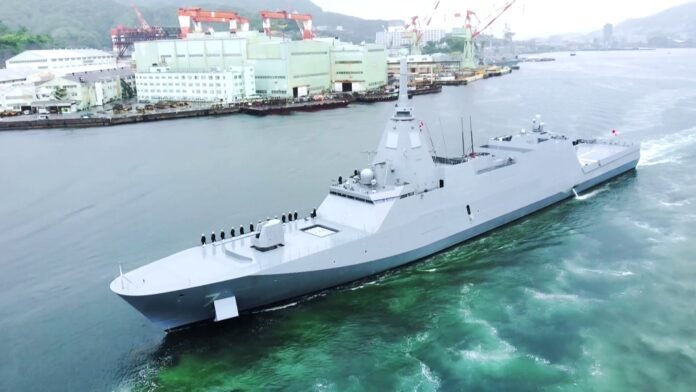Melbourne: Australia has selected Japan’s improved Mogami-class frigate design for its future fleet of general-purpose frigates, in a deal which further cements ties between the two US Indo-Pacific allies and gives Japan its first major defence export.
“Following a rigorous and competitive tender process, Mitsubishi Heavy Industries’ Mogami-class frigate was assessed as best able to quickly meet the capability requirements and strategic needs of the Australian Defence Force (ADF),” said the Australian Defence Department in a media release.
The Royal Australian Navy (RAN) will acquire 11 frigates under the $10 billion AUS ($6.5 billion US) programme, with the first three ships to be built in Japan and the remainder to be built in Western Australia, said Australian Deputy Prime Minister and Defence Minister Richard Marles.
Marles was speaking at a press conference in the Australian capital Canberra to announce the deal, where he said that it was decided that the Japanese design was the best option for the RAN following a rigorous selection process, which saw the Mogami-class beat out competition from German shipbuilder TKMS with its MEKO A200 design.
“This is a decision that is made about how we can get the best platform, the best capability for the Royal Australian Navy,” Marles said. He added that the Japanese government had agreed to give three production slots at Mitsubishi’s shipyard to Australia, which would see the first ship handed over in 2029 and enter service in 2030, with the third entering service in 2034.
Production of the remaining eight ships would then move to the Henderson Defence Precinct in Western Australia, where the Australian government has entered a Strategic Shipbuilding Agreement with a newly established subsidiary of shipbuilder Austal, known as Austal Defence Shipbuilding Australia.
Australian Minister for Defence Industry Pat Conroy, who was also at the press conference, said that the Mogami-class came out tops in terms of operating costs over its lifetime, and was the only of the candidates, which at one point also included South Korea’s Daegu-class and the Spanish ALFA3000 designs, that would be able to meet Australia’s tight schedule.
Euan Graham, an analyst with the Australian Strategic Policy Institute, said that for Washington, “it’s positive to have its two closest allies in the Western Pacific boosting their frontline naval capabilities and becoming more inter-operable with each other. There’s an important deterrent value to that signal of strategic cooperation in its own right.”
As to the Mogami-class itself, “integrating it will obviously pose challenges, but the key consideration in ‘speed to capability’ is likely to be Japan’s willingness to front-load production in Japan to meet Australian requirements ahead of its own,” Graham said. “It’s very likely that as part of the deal the overseas build will have to be increased from the current requirement for [three] hulls, as Australia’s own shipbuilding capacity is behind schedule.”
Marles said the Australian Mogami-class ships would have minimal changes from the ships going to the Japan Maritime Self-Defence Force (JMSDF) to reduce program risks, and would retain the Japanese combat system with the main changes being due to Australian regulatory requirements, such as the ship’s signages being translated into English.
He added that while the selection of the improved Mogami-class was driven by its capabilities alone, it also represented a very significant moment in the bilateral relationship between Australia and Japan. “There is no country in the world with whom we have a greater strategic alignment, and that is being reflected in a really blossoming defence relationship,” Marles said.
For Japan, the deal marks the first major arms export since the end of World War II. Japanese officials recently said that they hope the Mogami deal, including a willingness to share intellectual property with customers, will become a model for Japanese exports going forward. Japan has eight of 12 planned original Mogami-class frigates currently in service and will switch production over to the improved Mogami-class in 2028.
The JMSDF plans to acquire a total of 12 improved Mogami-class frigates, which are approximately 10 metres (30 feet) longer and feature improvements including being fitted with 32 Mk 41 Vertical Launch Systems (VLS) to launch SM-2 and SM-6 air-defence missiles and Tomahawk land-attack missiles.
The country had only announced the general-purpose frigate acquisition program in 2023 following a surface fleet review as it became apparent that the more expensive and complex ongoing Hunter-class frigate program would miss entry-into-service timelines and budget estimates. The review had also called for the frigates to be rapidly acquired owing to the regional geostrategic situation in the Indo-Pacific region as well as the need to replace the RAN’s existing fleet of seven ANZAC-class frigates, the oldest of which is 27 years old.






